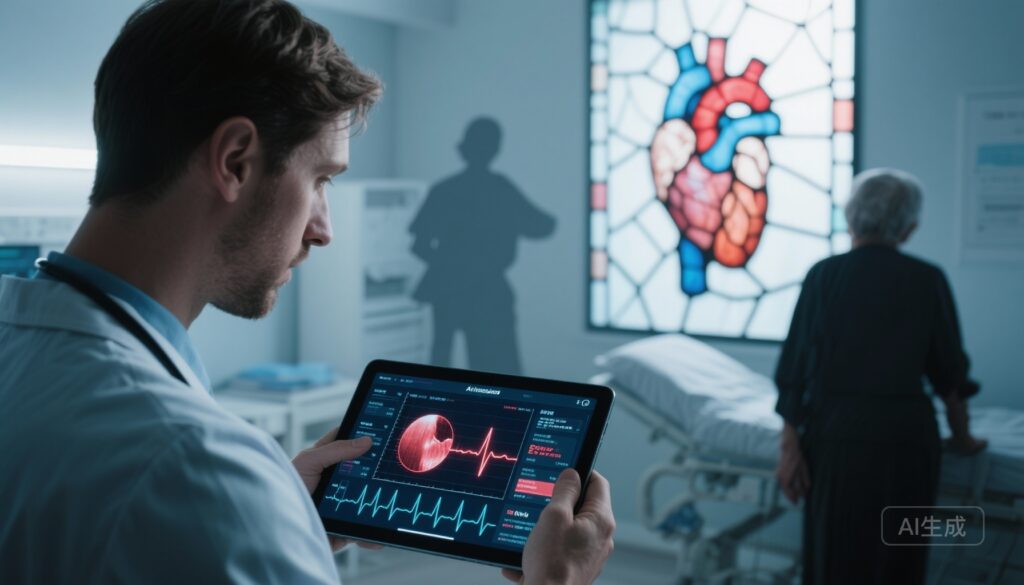Highlights
– An AI model (ATTRACTnet) combining ECG waveforms, echocardiographic measurements, demographics, and orthopedic-diagnosis codes achieved strong discrimination for ATTR‑CM (AUC ≈0.82–0.85) across internal and external test sets.
– In a multisite, single-arm clinical implementation, AI-guided case-finding identified 1471 patients with positive scores; 50 underwent diagnostic testing and 24 (48%) were diagnosed with ATTR‑CM—>2.8-fold higher positivity than historical controls.
– Most newly diagnosed patients (88%) initiated disease-modifying therapy rapidly; study authors emphasize need for randomized trials to assess downstream clinical benefits.
Background: disease burden and unmet need
Transthyretin cardiac amyloidosis (ATTR‑CM) is increasingly recognized as an important, treatable cause of heart failure with preserved or mildly reduced ejection fraction and increased left ventricular wall thickness in older adults. Availability of disease-modifying therapies such as tafamidis has transformed clinical urgency for earlier and accurate diagnosis. However, ATTR‑CM remains underdiagnosed: presentation is heterogeneous, and many affected patients are misattributed to hypertensive heart disease or aortic stenosis. Conventional case-finding relies on clinical suspicion, targeted imaging (bone scintigraphy), and laboratory exclusion of monoclonal protein, which are often underused.
Study design and methods
Jain and colleagues (JAMA Cardiology, 2025) developed and tested an AI-augmented clinical program (ATTRACTnet) to improve detection of ATTR‑CM. The work comprised two phases: (1) model development and validation; and (2) a single-system, multisite, single-arm open-label implementation trial to evaluate real-world performance.
Model inputs included raw ECG waveforms, echocardiographic measurements (not raw images), patient demographics, and diagnosis codes for orthopedic presentations associated with systemic amyloidosis (for example, carpal tunnel syndrome). Training used data from a large referral center with 5-fold cross-validation (internal test set n=799; mean age 75.1 years, 64.7% male), and external validation used an independent academic site (external test set n=422). The primary outcome during implementation was diagnosis of ATTR‑CM according to consensus criteria (noninvasive cardiac scintigraphy plus appropriate laboratory evaluation or biopsy when required).
Eligibility for the pragmatic implementation phase focused on patients with increased left ventricular (LV) wall thickness (≥12 mm) and an ATTRACTnet score ≥0.5. Exclusion criteria included prior ATTR testing, known hypertrophic cardiomyopathy, life expectancy <1 year, nursing home residence or advanced dementia, and LV thickening clearly explained (for example, uncontrolled hypertension or significant aortic stenosis) when thickness was <14 mm.
Key findings
Model performance: ATTRACTnet demonstrated good discrimination for ATTR‑CM with AUCs of 0.85 in internal cross-validation (range 0.77–0.85 across folds) and 0.82 (95% CI, 0.81–0.83) in the external test set. Performance was reportedly similar across major racial/ethnic groups analyzed (Hispanic, non-Hispanic Black, non-Hispanic White), suggesting acceptable calibration across subgroups in the available data.
Implementation and diagnostic yield: During the study period, the AI pipeline flagged 1,471 patients with scores ≥0.5. After applying eligibility criteria, 256 patients were eligible for outreach; 50 patients completed confirmatory diagnostic testing (nuclear scintigraphy and monoclonal protein testing) following physician and patient agreement. Of those tested, 24 (48%) met consensus criteria for ATTR‑CM. This diagnostic positivity rate was 2.8-fold higher than historical controls (15.3%; 95% CI, 13.1%–17.9%; P < .001). Relative to the prior year, there was an 18% increase in new ATTR‑CM diagnoses within the health system.
Treatment initiation: Among patients newly diagnosed with ATTR‑CM, 21 of 24 (88%) started disease-specific therapy (e.g., tafamidis) within three months, illustrating that detection translated rapidly into therapeutic action in most cases.
Safety and harms: The report focuses on diagnostic yield and downstream initiation of therapy rather than adverse events attributable to screening. No signal of direct harm from the screening process itself was described, though resource utilization and potential overtesting (false positives) remain relevant considerations.
Interpretation and clinical implications
This study demonstrates that a multimodal AI model integrated into a clinical program can efficiently identify patients at high likelihood of ATTR‑CM who were otherwise not being tested. Two features strengthen the practical relevance: the model uses routinely collected inputs (ECG waveforms, echo measurements, demographics, diagnosis codes), and implementation triggered real-world diagnostic pathways (PYP/DPD scintigraphy and monoclonal protein assessment).
From a clinical standpoint, a near-50% positivity among tested patients is substantial; it compares favorably to unguided screening approaches and suggests that AI can focus diagnostic resources where yield is highest. Rapid initiation of therapy in most diagnosed patients further supports clinical utility, because earlier treatment is believed to slow disease progression and reduce morbidity.
Comparisons with existing practice and prior evidence
Earlier work has shown that focused screening (for example, among older adults with increased LV wall thickness, carpal tunnel syndrome, or conduction disease) can identify previously unrecognized ATTR‑CM. What this study adds is demonstration of an automated, algorithm-driven pipeline that integrates multiple data modalities to prioritize patients for testing across a health system, rather than relying on individual clinician suspicion.
Strengths
– Multimodal model design that leverages commonly available data elements increases potential scalability.
– External validation supports generalizability beyond the derivation site.
– Real-world implementation data provide pragmatic evidence of diagnostic yield and immediate treatment uptake.
– Reported similar performance across several racial/ethnic groups addresses a common equity concern for AI models (though continued evaluation is required).
Limitations and caveats
– This was a nonrandomized, single-arm implementation study; increased detection cannot be causally attributed to the AI intervention versus contemporaneous secular trends without randomized comparison.
– Only 50 of 256 eligible patients underwent diagnostic testing, raising questions about barriers to testing (physician/patient acceptance, logistics, or competing clinical priorities) and potential selection bias—those tested may have had higher pretest probability.
– The threshold used (score ≥0.5) and eligibility rules affect yield and resource needs; optimization for different health systems or populations may be required.
– The study emphasizes diagnostic yield but does not provide long-term outcome data demonstrating that earlier detection via AI screening improves morbidity, mortality, quality of life, or cost-effectiveness.
– Generalizability to non-academic or resource-limited settings requires further study; access to scintigraphy and specialist care remains an implementation barrier.
Expert commentary and future directions
The findings are timely: as effective therapies for ATTR‑CM are available, improving early detection is clinically meaningful. AI-based case finding can reduce reliance on clinician suspicion alone, and multimodal models that combine ECG and echocardiographic features with relevant noncardiac signals (orthopedic diagnoses) reflect the systemic nature of transthyretin amyloidosis.
Key next steps include: randomized controlled evaluation comparing AI-augmented screening versus usual care to quantify effects on clinically meaningful outcomes (hospitalizations, functional status, survival) and health economics; deployment studies in diverse health systems to test scalability and equity; threshold optimization to balance sensitivity, specificity, and resource use; and assessment of patient-centered outcomes, including psychological effects of screening and diagnostic cascade harms.
Conclusion
ATTRACTnet is a promising example of AI-augmented case-finding for a treatable cardiomyopathy. In this nonrandomized multisite implementation, the program produced a high diagnostic yield and rapid initiation of therapy among newly diagnosed patients. However, the nonrandomized design, partial uptake of testing, and lack of outcome data mean that randomized trials and broader implementation research are necessary to confirm clinical benefit, cost-effectiveness, and equitable performance across settings.
Funding and trial registration
Trial registration: ClinicalTrials.gov Identifier: NCT06469372.
Funding and detailed disclosures are reported in the original publication (see Jain SS et al., JAMA Cardiology, 2025).
Selected references
1. Jain SS, Sun T, Pierson E, et al. Detecting Transthyretin Cardiac Amyloidosis With Artificial Intelligence: A Nonrandomized Clinical Trial. JAMA Cardiol. 2025 Nov 10:e254591. doi: 10.1001/jamacardio.2025.4591.
2. Maurer MS, Schwartz JH, Gundapaneni B, et al. Tafamidis Treatment for Patients with Transthyretin Amyloid Cardiomyopathy. N Engl J Med. 2018;379(11):1007-1016. doi:10.1056/NEJMoa1805689.



